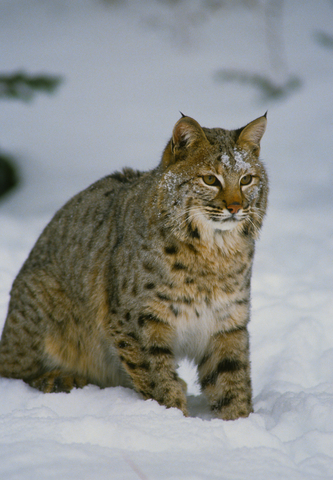 About
About
Another member of the cat family (Felidae) and a close relative of the lynx, the bobcat is known in scientific circles as “Lynx rufus”. The term “rufus” means “reddish” and refers to the colour of the bobcat’s summer coat. The common name “bobcat” refers to the creature’s short tail. In pioneering times, a man’s strength might be indicated by the saying, “He can whip his weight in wild cats”. Pioneers also called the bobcat a “catamount” or “cat of the mountain”.
Distribution
The bobcat is found throughout the United States, in most of Mexico, and in southern Canada. The Ontario harvest comes mainly from the north-central part of the province. In recent years, the bobcat has expanded its range northward from Michigan into Ontario via the islands west of Manitoulin Island. Movements into Ontario from Minnesota have also occurred. The bobcat’s range now completely surrounds Lake Superior. This species is not found as far north as the lynx because it lacks the large, snowshoe-like footpads, which give the lynx mobility on snowy terrain.
Description
Although the bobcat closely resembles the lynx, it has several features, which distinguish it from that species. Its legs are shorter and its feet, smaller and less hairy. Its ear tufts are shorter, and its tail lacks the full black tip that characterises the lynx. The bobcat has a fair sense of smell, but relies chiefly on its keen eyesight and hearing for hunting and survival. The male bobcat measures between 86.4 and 124.5 cm (34 and 49 in) in length. The female measures from 73.7 to 94 cm (29 to 37 in). The male averages 12.7 kg (28 lbs) and the female, 6.8 kg (15 lbs). The bobcat’s coat varies with the seasons and with the locality in which it lives. The winter coat tends to be paler than the summer coat, and is predominantly grey. In warm, arid country, buff-coloured coats are seen most often, while in mountainous, forested areas, black and grey colouration is more common. There is no colour variation between the sexes, and immature bobcats are spotted like their parents.
Life History
The female bobcat reaches sexual maturity at one year, and the male, at two. There are some indications that breeding may occur at any time, but the usual mating season runs from February through April. Females sometimes produce two litters in one year. The mates form no lasting union, but the male may be tolerated and allowed to assist in the provision of food at the end of the nursing period. Litters containing from one to four kittens are produced after a gestation period of 60 days. The newborns have mottled coats with subdued spots, and bear fairly strong facial markings. They open their eyes within three to nine days, and are weaned at two months of age. The female is protective of her young, but may abandon them, if humans disturb the den. The young, who are able to fend for themselves by fall, have a life expectancy of 10 to 15 years.
Habitat
The bobcat can inhabit wild, broken, mountainous country, timbered areas interspersed with old fields and partly open farmland, spruce thickets, cedar swamps, and open areas of hardwoods mixed with stands of hemlock, white pine or other conifers. The bobcat does better in agricultural and more populated areas than the lynx. It may also move into regions in which logging has produced openings in extensively forested terrain. This species may also be found in the American deserts, if suitable cover exists. Dens are usually made under vine-covered logs, in hollows of decomposing windfalls, in root depressions, or in small, natural rocky caves or recesses. Moss and dried leaves are sometimes brought to the shelters.
Food and Feeding Behaviour
Like the lynx, the bobcat depends on hares and rabbits. It will also resort to mice, squirrels, porcupines, mink, skunks, muskrat, moles, shrews, chipmunks, birds and their eggs, snakes, fish, crustaceans, insects, carrion and some plant matter. In agricultural areas, the bobcat sometimes preys on chickens, pigs, sheep and calves. In deep snow, it can pull down and kill a weakened deer. The bobcat prefers its established hunting routes, but will deviate from them to follow prey. It has several hunting styles: it may creep along steadily from cover to cover until close enough to pounce, lie motionless in a tree, watching and listening for unwary prey passing beneath, or crouch in ambush on a trail.
Habits
The bobcat is mainly nocturnal, but it may hunt during the day, particularly in winter. It is solitary, elusive and shy, and steals silently away at the first sign of danger. To escape from hounds, to chase prey or to take a rest, it will readily climb trees. The bobcat swims as well as the lynx but unlike the lynx, it does not become submissive when trapped. Home ranges vary greatly according to the food supply and the availability of a mate. Although it may travel great distances, the bobcat seldom maintains a home range of more than 5.2 square km (3 square mi). It may wander form 3.2 to 11.3 km (2 to 7 mi) in a single night. Along its travel routes, it maintains favourite spots for urination. Vocalization consists of caterwauls, screams made during the mating season and loud purrs and meows. Spitting and snarling with bared teeth is also an effective form of communication.
Population Changes
Scarcity of food is the principal factor affecting bobcat numbers. Human beings and dogs are the bobcat’s chief enemies. Diseases such as mange, rabies, feline enteritis (distemper) and leptospirosis have a limited impact on the population. Leptospirosis can infect animals and man, and causes fever, vomiting, weakness and meningitis. Parasites common to the bobcat include fleas, ticks, lice, roundworms, tapeworms and flukes.
Management
In areas inhabited by bobcats, the district offices of the Ministry consult with local trappers to set quotas.

You must be logged in to post a comment.